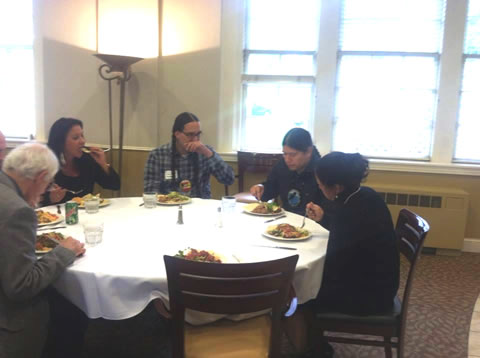 |
Canku Ota
|
 |
|
(Many Paths)
|
||
|
An Online Newsletter
Celebrating Native America
|
||
|
October
2014 - Volume 12 Number 10
|
||
|
|
||
|
Shaping The Future
of Indian Education
|
||
|
by Ramona Kitto Stately
|
||
|
We met at the Minnesota Humanities Center with folks from UW-Madison representing WCER (Wisconsin Center for Education Research) and WIDA (World-Class Instructional Design and Assessment Consortium); Dennis Olson from Minnesota Department of Education (MDE), Director of Indian Education; Elizabeth Watkins from MDE – Special Education, John Fila with the MN Collaborative Curriculum Project; Robin Nelson and Becky Buck from N. St. Paul Indian Ed.; Ethan Neerdaels from Osseo Indian Ed. and the Dakota Language Society, Joe Bendickson from the University of Minnesota and Dakota Language Society , Casey Demarais and Eden Bart from the Minnesota Humanities Center, Anton Treuer from Bemidji State University and Brenda Cassellius, the Commissioner of Education for the State of Minnesota. The agenda is simple was simple with discussions including:
Next Steps Anton Treuer was the facilitator and helped us connect possible opportunities to build future partnerships. I was extremely proud of the presentation by the Dakota Language Society presenters, Ethan Neerdaels and Joe (Sisokaduta) Bendickson. They have recently published a first ever Dakota Language curricula for K-12. It is being used for the first time in Minnesota in Osseo Area Schools, Minneapolis Public schools, University of Minnesota-Twin Cities, St. Cloud State, Bdote Language Immersion School and Dakota Wichohan to name a few. Their presentation explained that If someone attempted to learn the Dakota language in 2013, they would immediately realize the difficulty in reaching their language learning goals. Due to the ongoing suppression of Indigenous languages and life ways by euro-centric colonial empires, the Dakota language has experienced extreme language loss in the past century. The banishment and forced relocation from traditional homelands, paired with the generations of children forcibly removed from their families and placed in boarding/residential schools across the US and Canada has caused the Dakota language to currently have about 5 first speakers of Dakota that were born and raised in Minnesota Dakota communities along with approximately 20 speakers from Dakota communities outside of the state of Minnesota. The average age of fluent Dakota speakers is around 65 years old. If we do not do something now, the language will not be passed on to future generations. The statistics were staggering. I was proud to experience this young leadership and their passion. This curricula is the outcome of hundreds of volunteer hours that many young Native men and women in our community donated, showing their commitment to our Dakota language revitalization. All of their efforts to complete this curricula was volunteer, following our native philosophies; to take care of the people. I was grateful to witness such passion today from all the groups today. Wopida, Pidamiyaye ye! More Info: Dakhóta Iápi Okhódakichiye (DIO, Dakota Language Society) is a nonprofit organization of dedicated Dakota community members, language learners and speakers. The Dakota Language Society promotes revitalization of the Dakota language through the creation and distribution of Dakota language materials to be implemented in the home, community and classroom. Level 1 Materials created without grant funding, donations, or paid employees. All work was completed by Dakota people volunteering their time out of necessity for the language to thrive. (Level 1 Speak Dakota Textbook, Posters, Audio Companion CD) Utilizes the SLO/SDO Orthography already being used by thousands of children in North and South Dakota, thus unifying the prominent writing system across the Oceti Sakowin. The Dakhóta Iápi Okhódakichiye (Dakota Language Society) offers teacher/community training to help facilitate classroom and community language table use. For more information: http://www.dakhota.org/ |
|
|
||
|
|
||
| Canku Ota is a free Newsletter celebrating Native America, its traditions and accomplishments . We do not provide subscriber or visitor names to anyone. Some articles presented in Canku Ota may contain copyright material. We have received appropriate permissions for republishing any articles. Material appearing here is distributed without profit or monetary gain to those who have expressed an interest. This is in accordance with Title 17 U.S.C. Section 107. | ||
|
Canku Ota is a copyright ©
2000 - 2014 of Vicki Williams Barry and Paul Barry.
|
||
 |
 |
|
|
The "Canku
Ota - A Newsletter Celebrating Native America" web site and
its design is the
|
||
|
Copyright ©
1999 - 2014 of Paul C. Barry.
|
||
|
All Rights Reserved.
|
||
 I
was inspired to be a part of the Native Threads meeting at the Minnesota
Humanities Center today (Oct. 1 - ed.), a meeting designed to build
awareness about the work and projects we are doing as Indian Educators
with potential sponsors for our important work. Also, we met to
address the achievement/opportunity gap for Native students and
to see where there might be opportunities to build partnerships.
It was a grassroots meeting that will include a much larger voice
in the days to come.
I
was inspired to be a part of the Native Threads meeting at the Minnesota
Humanities Center today (Oct. 1 - ed.), a meeting designed to build
awareness about the work and projects we are doing as Indian Educators
with potential sponsors for our important work. Also, we met to
address the achievement/opportunity gap for Native students and
to see where there might be opportunities to build partnerships.
It was a grassroots meeting that will include a much larger voice
in the days to come.